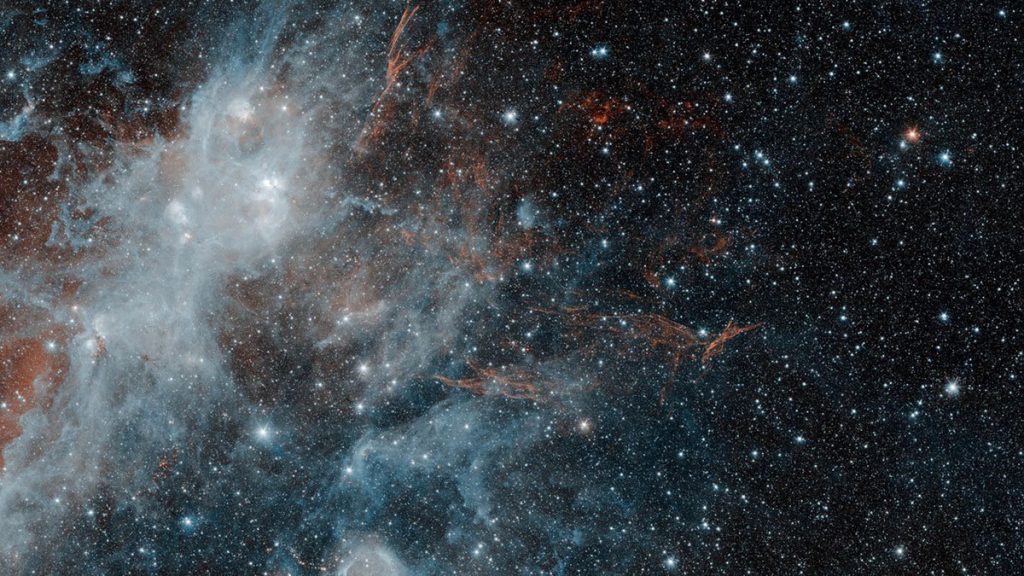A team of astronomers led by senior scientist Mireia Montes of the University of New South Wales in Australia have discovered that the missing dark matter in recently discovered galaxies can be explained by the effects of tidal disruption. They discovered the effects while studying the dark matter in the NGC 1052-DF4 using deep optical imaging aided by the data collected by the Hubble space telescope.
The team also found that the gravity forces of the neighboring massive galaxy NGC 1035 are tearing NGC 1052-DF4 apart. It was during this process, the dark matter is removed, while the stars feel the effects of the interaction with another galaxy at a later stage, the team found.
The discovery of the galaxy NGC 1052-DF2 in 2018 which missed dark matter was a surprise to astronomers, as it was understood that dark matter is a key constituent in current models of galaxy formation and evolution. It is known that without the presence of dark matter, the primordial gas would lack enough gravitational pull to start collapsing and forming new galaxies.
In 2019, the galaxy NGC 1052-DF4 was discovered which missed dark matter. This had further triggered intense debates among astronomers about the nature of these objects. The new Hubble data have been used to explain the reason behind the missing dark matter in NGC 1052-DF4, which resides 45 million light-years away.
NASA report says that thanks to Hubble’s high resolution, the astronomers could identify the galaxy’s globular cluster population. The 10.4-meter Gran Telescopio Canarias (GTC) telescope and the IAC80 telescope in the Canary Islands of Spain were also used to complement Hubble’s observations by further studying the data.
Globular clusters (spherical groups of stars outside a galaxy that orbit the parent galaxy’s core) are thought to form in the episodes of intense star formation that shaped galaxies. Their compact sizes and luminosity make them easily observable, and they are therefore good tracers of the properties of their host galaxy. In this way, by studying and characterizing the spatial distribution of the clusters in NGC 1052-DF4, astronomers can develop insight into the present state of the galaxy itself. The alignment of these clusters suggests they are being “stripped” from their host galaxy, and this supports the conclusion that tidal disruption is occurring.
By studying the galaxy’s light, the astronomers also found evidence of tidal tails, which are formed of material moving away from NGC 1052-DF4. This further supports the conclusion that this is a disruption event. Additional analysis concluded that the central parts of the galaxy remain untouched and only about 7% of the stellar mass of the galaxy is hosted in these tidal tails. This means that dark matter, which is less concentrated than stars, was previously and preferentially stripped from the galaxy, and now the outer stellar component is starting to be stripped as well.
The discovery of evidence to support the mechanism of tidal disruption as the explanation for the galaxy’s missing dark matter has not only solved an astronomical conundrum, but has also brought a sigh of relief to astronomers. Without it, scientists would be faced with having to revise our understanding of the laws of gravity.
What is Dark Matter?

Dark matter is a form of matter thought to account for approximately 85% of the matter in the universe and about a quarter of its total mass–energy density. Scientists believe that presence of Dark Matter is implied in a variety of astrophysical observations, including gravitational effects that cannot be explained by accepted theories of gravity unless more matter is present than can be seen.
Primary evidence for dark matter comes from calculations showing that many galaxies would fly apart, or that they would not have formed or would not move as they do, if they did not contain a large amount of unseen matter.
Other lines of evidence include observations in gravitational lensing and in the cosmic microwave background, along with astronomical observations of the observable universe’s current structure, the formation and evolution of galaxies, mass location during galactic collisions, and the motion of galaxies within galaxy clusters.
Although the existence of dark matter is generally accepted by the scientific community, some astrophysicists, intrigued by certain observations which do not fit some dark matter theories, argue for various modifications of the standard laws of general relativity, such as modified Newtonian dynamics, tensor–vector–scalar gravity, or entropic gravity.
